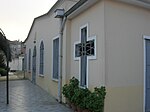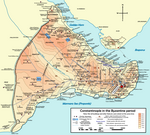Atik Mustafa Pasha Mosque
11th-century mosques18th-century mosquesByzantine church buildings in IstanbulChurches and monasteries of ConstantinopleFatih ... and 5 more
Golden HornMosques converted from churches in IstanbulOttoman mosques in IstanbulReligious buildings and structures completed in 1059Religious buildings and structures completed in 1512

Atik Mustafa Pasha Mosque (Turkish: Atik Mustafa Paşa Camii; also named Hazreti Cabir Camii) is a former Eastern Orthodox church in Istanbul, converted into a mosque by the Ottomans. The dedication of the church is obscure. For a long time it has been identified with the church of Saints Peter and Mark, but without any proof. Now it seems more probable that the church is to be identified with Saint Thekla of the Palace of Blachernae (Greek: Άγία Θέκλα τοῦ Παλατίου τῶν Βλαχερνών, Hagia Thekla tou Palatiou tōn Vlakhernōn). The building belongs stylistically to the eleventh-twelfth century.
Excerpt from the Wikipedia article Atik Mustafa Pasha Mosque (License: CC BY-SA 3.0, Authors, Images).Atik Mustafa Pasha Mosque
Çember Sokağı, Istanbul
Geographical coordinates (GPS) Address Nearby Places Show on map
Geographical coordinates (GPS)
| Latitude | Longitude |
|---|---|
| N 41.0386 ° | E 28.944 ° |
Address
Hz. Cabir Cami
Çember Sokağı
34087 Istanbul
Türkiye
Open on Google Maps









